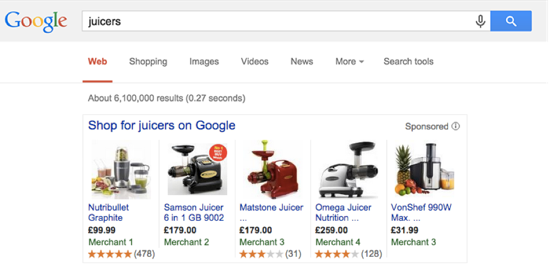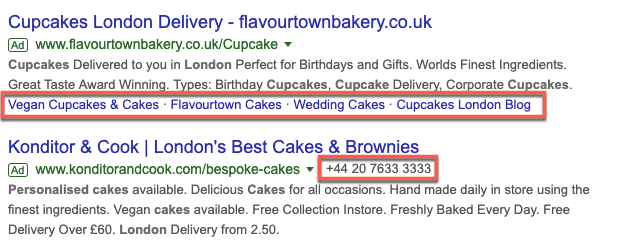Six most common ecommerce advertising mistakes (and how to fix them)
Online advertising is one of the quickest ways to send targeted traffic to your ecommerce site and start generating sales. That is if you do it right.
If you don’t, it can be one of the quickest ways to lose money.
Not only that but you may also end up thinking that online advertising, be it pay-per-click (PPC) advertising or social media advertising, doesn’t work for your business.
Here’s the thing: online advertising works for all ecommerce businesses. It can and will work for yours, too. You just need to fix some of the ecommerce advertising mistakes you’re making.
So if you want to stop throwing hundreds or thousands of pounds down the online advertising vortex with little result, read on to learn how to avoid and overcome these six mistakes.
1. You’re not using Google Shopping
Ignoring Google Shopping is a mistake. Why? Because it’s an effective tool for getting your products in front of your potential customers. So if you’re not using it (or maybe you’ve not yet heard about it?), now’s the time to get started.
How to fix it
If you’re not familiar with it, this is Google’s dedicated shopping engine where businesses can advertise their products directly into the Google search results and in front of ready-to-buy audiences.
Here’s how Google Shopping ads look:

So when users run a search for one of your products, they’ll be able to get all the information they need about it before they even click through to your site.
Not sure if your small ecommerce business would benefit from using it? Here are a few good reasons to give it a try:
- It gives your shop the opportunity to show up multiple times in the search engine results – as a website result, a PPC result and a Shopping result.
- The results are displayed in a special box either on the top or on the side of the Google search results. This makes these ads much more prominent than regular search results or ads, which can result in more clicks and sales.
- Google Shopping is proven to have 30% higher conversion rates on desktop and 21% higher conversion rates on mobile.
- You get to save money since you’ll only be paying for clicks that are on the verge of converting into sales.
If you’re ready to try it out, read our beginner’s guide to Google Shopping Ads to learn how to get started.
2. You’re not using Ad extensions
You want to stand out and be the one to get that customer who is searching for your products. So why aren’t you taking advantage of Google Ad extensions to grab users’ attention and increase the effectiveness of your ads?
How to fix it
Ad extensions are additional bits of useful information about your business or products that are displayed below your text ad.
Here’s how a typical ad looks:

And here’s how ads with extensions look:

As you can see, this second set of ads contain more information such as quick navigation to a few key pages on the site and a phone number.
There are also other ad extensions you can use such as location, promotions, pricing. Read our beginner’s guide to Google Ad extensions to learn more about all seven of them, see some examples and determine which ones you can use in your next ad campaign.
The best part? Google Ad extensions are free so you have no excuse not to use them. Not only will your ads stand out but you’ll also entice more prospects to click since ads with extensions see a 10-15% increases in click-through rates, compared to ads without.
3. Your ads are all about you
This is one of the most common mistakes, and not just in online advertising but in everything related to promoting a business online.
It’s not surprising. As a small business owner, you pour your blood, sweat and tears into your shop. You’re so proud of it that you tell everyone, every chance you get, about how awesome your new business and products are.
But that’s a big mistake, and you know why? Because no one really cares about your business or products. People don’t care that you just launched your online shop or that you sell homemade jam or jewellery. They also don’t care that you say your business is different.
What they do care about is what’s in it for them.
For example, does this ad tell you what’s in it for you or why you should care?

How about this one?

No, they don’t.
How to fix it
Your ads aren’t about you. They’re about your target audience, the potential customers you are trying to attract to your site and entice to buy from you.
So when writing your ads, make sure you focus the message on them and their needs, wants, desires and goals.
Tell them how strong and fit they’ll become once they buy those dumbbells, or how much time and money they’ll save on gym memberships.
Or tell them how they’ll gain the admiration or envy of their friends with that handmade piece of jewellery.
For your ads to work, you need to make your message about your ideal customers and how your products can help to make them happier, healthier, wealthier.
Here are two good examples to get inspiration from:


4. You’re sending all traffic to your homepage
If you’re promoting a specific product, category of products or offer in your ad but sending prospects to your shop’s homepage, don’t be surprised if users leave your site in seconds.
The goal of your ads and your ecommerce website is to get potential customers to your checkout page as quickly as possible and in as fewer steps as possible.
So when you link your ads to your homepage, you’re not only adding extra and unnecessary steps. You’re also adding to their frustration since the page they land on isn’t relevant to what you promised in your ad. That’s a bad customer experience.
How to fix it
Stop sending traffic to your homepage. Stop wasting your prospects’ time.
If you promised “running shoes for women” in your ad, then send them to exactly that product category page on your site. Don’t make them search through your entire website to find that product because most won’t. They’ll choose to leave instead.
So go ahead and double check all your ads to make sure none is linked to your homepage. Instead, send visitors to the specific landing pages or product pages that are most relevant to your ad and their search query.
5. You’re directing prospects to a broken or slow-loading website
Your ads are great. So are your products. Too bad no one can buy them.
If your site is broken or takes too long to load, don’t be surprised if your prospects get frustrated and leave.
Check out these stats:
- 47% of customers expect a webpage to load within 2 seconds.
- Just one second of delay in page load time can reduce conversions by 7%.
- 79% of customers who had a bad experience with website performance are less likely to become repeat buyers.
How to fix it
Check your site’s speed score using Google’s PageSpeed Insights. Use the recommendations to fix any issues and speed up your site. Also, read this post to learn how to improve your site’s speed.
In addition, test your links and pages regularly to make sure everything works properly and visitors have a great experience on your site. If you don’t, you’ll not only waste your ad budget but you could also find yourself getting tens of negative reviews and alienating prospects who will never come back.
6. You’re blending in, not standing out
It’s unlikely that your business and products are unique. This means that you’re going up against many other companies that are offering the same products you’re offering.
If you’re not spying on your competitors’ ads to see what they’re promising and how they’re attracting customers, you might be blending in without even knowing.
How to fix it
Look at the ads and campaigns that your closest competitors are running on Google and social media. What are they promising? Who are they targeting? How are they standing out? Then use those insights to differentiate yourself.
Wrapping up
There you have – six common ecommerce advertising mistakes that you need to avoid in your next campaign.
If you’re already running an ad campaign as you’re reading this, make sure to check that you’re not making any of these mistakes but if you are, use the advice in this post to fix them as quickly as possible.
